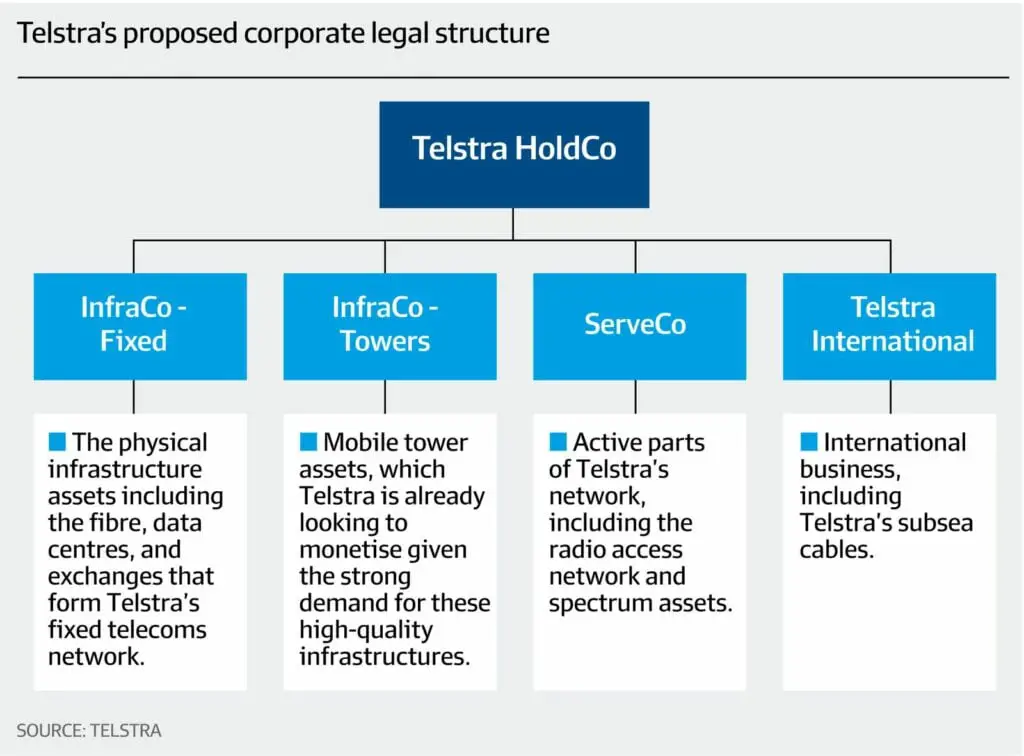In the competitive telecommunications industry, companies are always looking for innovative ways to stay ahead of their rivals. One of these strategies used by companies is vertical integration, a business strategy where a company acquires, partners, or merges with other businesses along its supply chain. Telstra’s vertical integration is one of the most comprehensive in the telecommunications industry, worldwide.
Telstra is an Australian telecommunications company that offers services such as the building and operation of telecommunications networks. This company also provides services such as internet access, mobile telecommunications, and pay television. Telstra has tried using vertical integration to dominate the telecommunications industry in Australia since 1990. We will look at Telstra’s vertical integration strategy and its effect on the company, whether this has been of advantage or disadvantage to it.
Related: Tesla’s Vertical Integration Strategies
What is the vertical integration strategy?
Vertical integration is a business strategy where a company acquires steps in the supply chain. A company may apply the vertical integration strategy by creating some of these steps in the supply chain, or it may acquire already established companies that are in its supply chain, or the company may even merge with another one in order to acquire a particular step in the supply. The major reasons why companies like Teslstra use vertical integration are to increase their profit margins and improve the quality of their products or services.
See also: Nike’s Supply Chain Issues and Management
Telstra Vertical Integration Strategies and Examples
- Telstra’s vertical integration strategy can be seen in its ownership or partnership with some media companies such as Foxtel, Fetch TV, etc. It is also vertically integrated by owning other companies such as EPiCON (a software company), Telstra Purple (which offers cyber security, software development, etc.). With these examples of vertical integration by Telstra, it gives the company a competitive advantage in providing exclusive services that competitors cannot match it.
- Telstra’s backward vertical integration examples can be seen in its development of several network infrastructures such as fixed-line infrastructure of copper and fiber as well as its mobile network towers.
- Another example of Telstra’s vertical integration is its established data centers and cloud infrastructure to support its expanding range of digital services. This backward integration initiative enables Telstra to offer its customers reliable and scalable cloud-based solutions. In fact, it is another source of revenue for the company as others can pay to use its cloud services.
- Because of its partnership with and owning of some media companies, Telstra is also forward vertically integrated through its bundled service offerings combining telecommunications, internet, and media services. By offering these comprehensive packages, Telstra can attract customers who seek convenience, cost savings, and a unified experience across various services.
See also: Vertical Integration Examples of Companies
Benefits of Telstra’s Vertical Integration Strategies
- Telstra vertical integration helps it to gain a competitive advantage in the telecommunications market. The company dominates the Australian telecommunications industry and has about 50% market share of mobile users.
- Telstra’s Vertical integration example of owning network infrastructure enables it to have greater control over the network’s reach, quality, and capacity. This in turn translates to improving the quality of its services.
- It increases efficiency while reducing costs.
- The expansion into media and content delivery has allowed Telstra to diversify its revenue streams. Offering a wider range of services reduces its dependence on traditional telecommunications revenue and creates additional sources of income.
- Telstra’s vertical integration ensures the company streamlines its operations and better manages its resources.
Related: Amazon’s Vertical Integration Strategies
Disadvantages of Telstra’s Vertical Integration
- Vertical integration may limit innovation and make some units to be redundant.
- It reduces flexibility as businesses become too big to adapt quickly to changing market conditions.
- Vertical integration attracts increasing regulatory scrutiny due to concerns about monopolistic practices.
Vertical integration may limit innovation
Vertical integration may limit innovation and make some units to be redundant. Telstra has realized that some of its infrastructures are not well utilized and that selling some of them can increase its revenue more than merely owning these infrastructures. It started by selling some of these infrastructures in 2021 when it sold a 49% stake in its Amplitel mobile towers for $2.8 billion.
Telstra’s vertical integration structure may reduce its flexibility
Telstra being vertically integrated can reduce its flexibility as the business becomes too big to adapt quickly to changing market conditions. For example, in its fixed-line infrastructure, Telstra’s vertical integration caused it to be too slow to build the National Broadband Network (NBN). This has made the company go from a provider of both the fixed line infrastructure and retail service provider to now acting as a mere retail reseller of access to the NBN, where it competes with other service providers.
Vertical integration attracts increasing regulatory scrutiny
Vertical integration attracts increasing regulatory scrutiny due to concerns about monopolistic practices. The Australian government argued that Telstra’s vertical integration affects all Australians and the economy more generally through higher telecommunications prices and reduced innovation and investment in the sector.

In fact, the Australian government has intentions of selling the NBN but says government legislation does not allow vertically integrated telcos like Telstra to bid for the NBN. This is to prevent monopoly. It means if Telstra is interested in acquiring the NBN, then it must restructure by splitting the company into separate businesses.
Related:
- IKEA Supply Chain Problems and Issues
- McDonald’s Supply Chain Issues and Process
- Netflix’s Vertical Integration Strategy and Examples
Nansel is a serial entrepreneur and financial expert with 7+ years as a business analyst. He has a liking for marketing which he regards as an important part of business success.
He lives in Plateau State, Nigeria with his wife, Joyce, and daughter, Anael.
